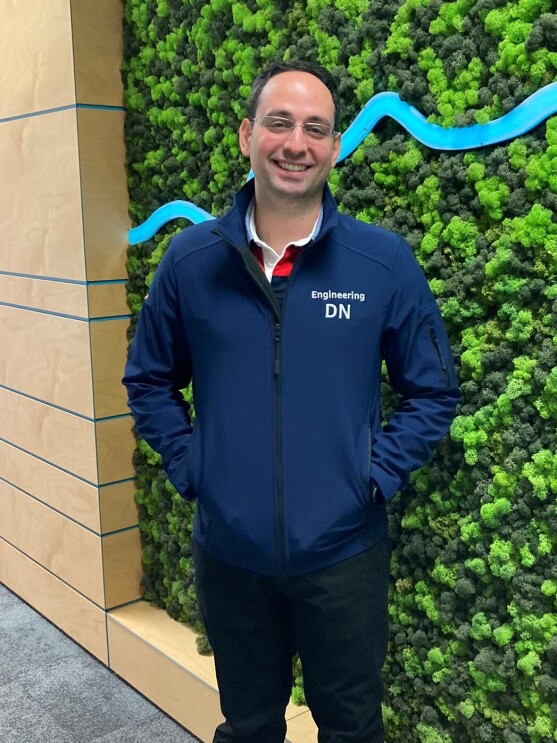Engineers at Amazon work across a wide range of disciplines – from mechanical and electrical engineers working on developing new technology, to software and data engineers pushing the limits of computing.
Across all of these areas, one common value is a commitment to improving the world around us. Whether it be through inventing new electric vehicle infrastructure, by using supercomputers to improve their efficiency, or by developing new ways to use Amazon technology to assist people with disabilities, they are working to ultimately improve the lives of others.
We spoke to three of our engineers to understand how the work they do is helping to improve the world, and learn a little bit about what inspired them to enter the industry.
Neil Ashton - working with supercomputers
We spoke to Neil Ashton, who works as a Principal Computational Engineering Specialist at Amazon Web Services (AWS). Neil helps AWS’s customers to use high performance computing (HPC) and cutting-edge simulation tools to find solutions to complex engineering problems.
“When I was growing up, I loved Star Trek and that sparked an interest in both engineering and space travel. I was inspired by the idea of working with a company like NASA and being part of the next generation of space travel. Mechanical and electrical engineering are normally what come to mind if you’re thinking about this type of career, but what I quickly realised is that there are so many types of engineering out there!
“Those interested in an engineering career could also consider areas like data engineering, software engineering and the work that I do - computational engineering - which at its core means solving really difficult engineering problems using computers.
“I sit inside our HPC organisation that develops AWS services so that customers can use supercomputers to run complex simulations to try to find answers to important scientific and engineering problems - problems that would normally take many months and large sums of money to test in the real world.
 Neil Ashton
Neil Ashton“One project that really stands out to me is when FORMULA 1 (F1) turned to AWS to help design its next generation of race car, which is now being used by F1 teams this season. Previously, cars were struggling to overtake one another on the track due to a loss of downforce; F1 wanted to redesign the car to increase wheel-to-wheel racing, in turn creating more intense racing and excitement on the track.
“Rather than build a new car and test its aerodynamic profile in a wind tunnel, which can be costly and take a long time, F1 were able to create a virtual simulation and use some clever computer engineering to simulate the flow of air over the cars. The project used thousands of computers to run detailed simulations of over 550 million data points that model the impact of one car's aerodynamic wake on another. Because of our work, F1 was able to reduce the average time to run simulations by 80% and deliver a car that has created a really exciting 2022 F1 season!”
Neil’s experience in engineering has taught him some valuable lessons about pursuing a career in the sector, which he always shares with those entering into a career or degree in engineering.
“Remember that engineering is a very broad discipline, much more so than people think. It’s not just the traditional idea of building physical things with your hands, but now also software development and Machine Learning. I personally think it’s one of the most rewarding, diverse and exciting fields to be in.
“For those in the UK, ThisisEngineering.org.uk and the This is Engineering social media channels are a great place to get insight and advice for anyone interested in a career in engineering.
Doros Nicolaides - electrifying a transport network
For Doros Nicolaides, there was never any question what he wanted to do with his career. Throughout his studies, he was fascinated by how electrical engineering could be used to improve the world around him.
“At Cambridge, I studied engineering for sustainable development. This was perfect as it allowed me to combine my understanding of electrical engineering with a high-level perspective of sustainability.
“The focus of my career in engineering has almost always been on engineering sustainable solutions to the problems facing our society. For example, when I was doing my masters, I researched the electrification of roads transportation, and then followed that up with a PhD focusing on the infrastructure requirements for the widespread electrification of UK roads.”
 Doros Nicolaides
Doros NicolaidesDoros works as a Senior Project Manager at Amazon in a team that specialises in Sustainability Electricity Engineering. In particular, Doros focuses on the charging infrastructure required to make the transition to net-zero by 2040, specialising in the design, planning and deployment of the charging infrastructure across Amazon’s European-wide ‘last mile’ network – the Amazon vehicles that deliver packages to customers doorsteps.
The work Doros does each day is crucial to Amazon’s electrification programmes and overall sustainability targets. As well as retrofitting existing facilities with charging technology, all new delivery stations are designed with the physical layout and electrical capacity to meet the needs of our current and future electric delivery fleets.
“These ripple effects are just as important as our direct impact. I’m proud to say that Amazon is a leader in the adoption of electric vehicles. Our successful implementation of an electric delivery fleet will show the rest of the world what’s possible.”
“This has become my dream job. It has given me an opportunity to combine the academic and industrial worlds that I love and create something really meaningful.”
Beth Holmes - teaching Alexa new things everyday
Beth Holmes is an engineer who’s developing Amazon’s Alexa, streamlining the ways in which the technology can respond and interact with users and the environment around it.
“I work as a Principal Knowledge Engineer in a department called ‘Alexa Information’. My team specifically works on Alexa’s question-answering capability, and our goal is to create a quick and convenient way for customers to find out the information that they need.
“For example, they can ask for the weather without needing to find their phone. When we launched notifications, that meant Alexa could proactively update customers on the information they might want to stay up to date with, that could be the result for their favourite sports team or a change in a stock price.”
 Beth Holmes
Beth HolmesAlthough Beth’s work to develop Alexa’s abilities is very useful for the average user, it is game-changing for those who may not be able to use other systems to get updates and information.
“The work that we do is quite useful for people who are physically healthy, but it is vital for people who cannot easily use their phones or laptops, such as the elderly and the blind, as well as those people with disabilities who may lack mobility.
“It’s very important to me that Alexa can be a force for good – a tool which can help its users and improve their lives. It’s a really big motivator for me, and influences the projects that I work on.
“One of the projects that I worked on that I was particularly proud of was our response at the start of the COVID-19 pandemic. When the pandemic started, my team turned around one of our fastest data launches, releasing an update that would enable Alexa to answer customer questions about case numbers by location, as well as providing them with other information about the pandemic.”
Learn more about National Engineering Day and how you can get involved.
![Facebook_cover_(2)[1].png National Engineering Day](https://assets.aboutamazon.com/2c/1e/57c8d40d494584788cba49c254b2/facebook-cover-2.png)







